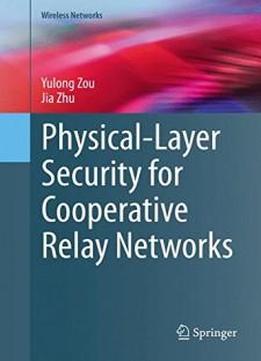
Physical-layer Security For Cooperative Relay Networks (wireless Networks)
by Jia Zhu /
2016 / English / PDF
1.8 MB Download
This book presents physical-layer security as a promising
paradigm for achieving the information-theoretic secrecy required
for wireless networks. It explains how wireless networks are
extremely vulnerable to eavesdropping attacks and discusses a
range of security techniques including information-theoretic
security, artificial noise aided security, security-oriented
beamforming, and diversity assisted security approaches. It also
provides an overview of the cooperative relaying methods for
wireless networks such as orthogonal relaying, non-orthogonal
relaying, and relay selection.
This book presents physical-layer security as a promising
paradigm for achieving the information-theoretic secrecy required
for wireless networks. It explains how wireless networks are
extremely vulnerable to eavesdropping attacks and discusses a
range of security techniques including information-theoretic
security, artificial noise aided security, security-oriented
beamforming, and diversity assisted security approaches. It also
provides an overview of the cooperative relaying methods for
wireless networks such as orthogonal relaying, non-orthogonal
relaying, and relay selection.
Chapters explore the relay-selection designs for improving
wireless secrecy against eavesdropping in time-varying fading
environments and a joint relay and jammer selection for wireless
physical-layer security, where a relay is used to assist the
transmission from the source to destination and a friendly jammer
is employed to transmit an artificial noise for confusing the
eavesdropper. Additionally, the security-reliability tradeoff
(SRT) is mathematically characterized for wireless communications
and two main relay-selection schemes, the single-relay and
multi-relay selection, are devised for the wireless SRT
improvement. In the single-relay selection, only the single best
relay is chosen for assisting the wireless transmission, while
the multi-relay selection invokes multiple relays for
simultaneously forwarding the source transmission to the
destination.
Chapters explore the relay-selection designs for improving
wireless secrecy against eavesdropping in time-varying fading
environments and a joint relay and jammer selection for wireless
physical-layer security, where a relay is used to assist the
transmission from the source to destination and a friendly jammer
is employed to transmit an artificial noise for confusing the
eavesdropper. Additionally, the security-reliability tradeoff
(SRT) is mathematically characterized for wireless communications
and two main relay-selection schemes, the single-relay and
multi-relay selection, are devised for the wireless SRT
improvement. In the single-relay selection, only the single best
relay is chosen for assisting the wireless transmission, while
the multi-relay selection invokes multiple relays for
simultaneously forwarding the source transmission to the
destination.
Physical-Layer Security for Cooperative Relay Networks is
designed for researchers and professionals working with
networking or wireless security. Advanced-level students
interested in networks, wireless, or privacy will also find this
book a useful resource.
Physical-Layer Security for Cooperative Relay Networks is
designed for researchers and professionals working with
networking or wireless security. Advanced-level students
interested in networks, wireless, or privacy will also find this
book a useful resource.











